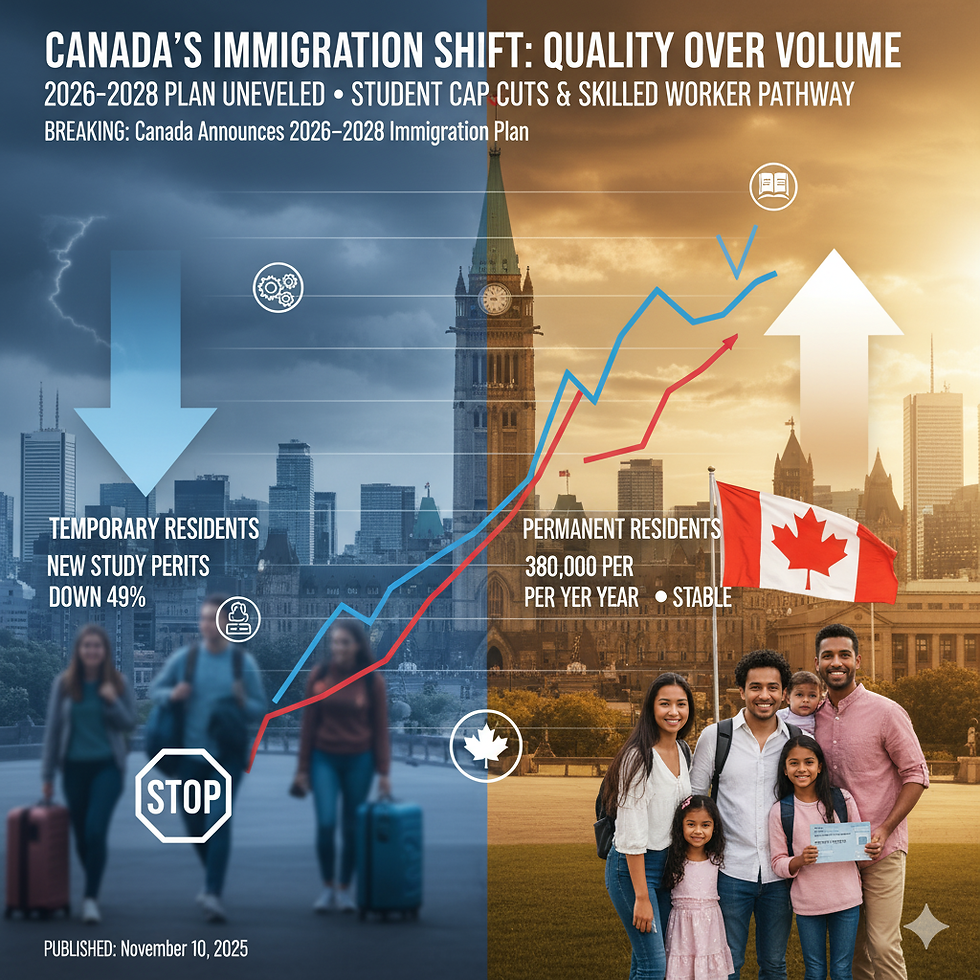Canada Tightens Immigration: Visa Refusals on the Rise
- Ansari Immigration

- Sep 4, 2024
- 4 min read
Canada has long been known as a welcoming destination for immigrants, but recent trends suggest a shift in the country's approach to immigration. With visa refusals on the rise and fewer visas being issued, it's crucial for potential immigrants to understand the changing landscape.
This blog explores the reasons behind Canada's tightening immigration policies and provides valuable insights for those planning to make Canada their new home.
The Changing Face of Canadian Immigration
Canada has traditionally maintained an open-door policy towards immigration, recognizing the economic and cultural benefits that newcomers bring to the country. However, recent data shows a significant increase in visa refusals and a decrease in the number of visas issued1. This shift has left many prospective immigrants wondering about their chances of successfully entering Canada.

Rising Visa Refusal Rates in Canada
According to Immigration, Refugees and Citizenship Canada (IRCC), the visa refusal rate has increased by 15% over the past three years2. This trend is particularly noticeable in certain categories of visas, such as:
Temporary Resident Visas (TRVs)
Study Permits
Work Permits
The reasons for these refusals vary, but common factors include:
Incomplete or inaccurate applications
Failure to meet eligibility criteria
Concerns about the applicant's intention to leave Canada after their authorized stay
Fewer Visas Being Issued
In addition to higher refusal rates, Canada is also issuing fewer visas overall. This decrease is partly due to the COVID-19 pandemic, which led to travel restrictions and reduced processing capacity at visa offices. However, even as pandemic-related restrictions ease, the number of visas issued has not returned to pre-pandemic levels3.

Reasons Behind Canada's Stricter Immigration Approach
Several factors contribute to Canada's more stringent approach to immigration:
1. Economic Considerations
The Canadian government is focusing on attracting immigrants who can fill specific labor market needs and contribute to the country's economic growth. This targeted approach may result in
fewer visas being issued overall, but with a higher emphasis on quality over quantity.
2. Security Concerns
Increased global security threats have led to more rigorous screening processes for visa applicants. This enhanced vetting can result in longer processing times and higher refusal rates for applicants who don't meet the stricter security criteria5.
3. Integrity of the Immigration System
Canada is working to maintain the integrity of its immigration system by cracking down on fraud and misrepresentation. This includes more thorough checks on applicants' backgrounds and intentions, which can lead to higher refusal rates6.
4. Capacity and Resource Management
The Canadian immigration system has been facing significant backlogs, particularly in the wake of the COVID-19 pandemic. By issuing fewer visas and being more selective, the government aims to manage its resources more effectively and reduce processing times for priority applications7.
Impact on Prospective Immigrants
For those planning to immigrate to Canada, these changes have several implications:
Increased Competition: With fewer visas available, competition for spots in various immigration programs has intensified.
Longer Processing Times: The more thorough vetting process can lead to extended wait times for visa applications.
Higher Standards: Applicants may need to meet more stringent criteria to be successful in their visa applications.
Greater Emphasis on Skills and Experience: Canada is prioritizing immigrants who can fill specific labor market gaps, making it more challenging for those without in-demand skills.

Strategies for Improving Your Chances
Despite the challenges, there are steps you can take to improve your chances of successfully immigrating to Canada:
Research and Prepare Thoroughly
Understand the specific requirements for your chosen immigration program and ensure you meet all criteria before applying. The official IRCC website is an excellent resource for up-to-date information.
Enhance Your Skills and Qualifications
Focus on developing skills that are in high demand in Canada. This may include obtaining additional certifications or gaining relevant work experience.
Improve Your Language Proficiency
Strong language skills in English or French are crucial for many Canadian immigration programs. Consider taking language courses or practicing to improve your proficiency.
Consider Alternative Pathways
Explore various immigration programs and pathways to find the one that best suits your qualifications and circumstances. Provincial Nominee Programs, for example, may offer opportunities for those who don't qualify for federal programs10.
Seek Professional Assistance
Consider working with a licensed immigration consultant or lawyer who can guide you through the application process and help you avoid common pitfalls11.
The Future of Canadian Immigration
While Canada's current approach to immigration may seem more restrictive, it's important to note that the country still maintains a strong commitment to welcoming newcomers. The government's immigration targets remain high, with plans to admit over 400,000 new permanent residents annually in the coming years12.However, the focus is shifting towards a more strategic and targeted approach to immigration. This means that while overall numbers may remain high, the selection process is becoming more competitive and focused on specific skills and attributes that align with Canada's economic and social goals.

Questions and Answers
Q: How long does it typically take to process a Canadian visa application?
A: Processing times vary depending on the type of visa and current application volumes. For the most up-to-date processing times, visit the official IRCC website: Check application processing times
Q: Can I appeal if my Canadian visa application is refused?
A: In most cases, you cannot appeal a visa refusal. However, you may be able to reapply if your circumstances change or if you can provide additional information that addresses the reasons for the refusal. For more information, visit: After you apply: Get next steps – Visa applications
Q: What are the most in-demand skills for immigrants in Canada?
A: In-demand skills can vary by province and change over time. However, some consistently sought-after fields include healthcare, information technology, skilled trades, and engineering. For current information on in-demand occupations, check the Government of Canada's Job Bank: Explore careers by outlook




Comments